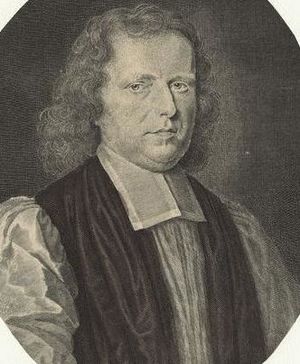John Sharp (bishop) facts for kids
Quick facts for kids The Most Reverend and Right Honourable John Sharp |
|
|---|---|
| Archbishop of York | |
 |
|
| Archdiocese | York |
| Enthroned | 1691 |
| Reign ended | 1714 (death) |
| Predecessor | Thomas Lamplugh |
| Successor | Sir William Dawes, Bt. |
| Other posts | Dean of Norwich (1681–89) Dean of Canterbury (1689–91) |
| Personal details | |
| Born | 16 February 1645 |
| Died | 2 February 1714 (aged 68) |
| Buried | York Minster |
| Nationality | British |
| Denomination | Anglican |
| Spouse | Elizabeth Palmer (m.1676) |
| Education | Bradford Grammar School |
| Alma mater | Christ's College, Cambridge |
John Sharp (born February 16, 1645 – died February 2, 1714) was an important English church leader. He served as the Archbishop of York, a very high position in the Church of England.
Contents
Early Life and Education
John Sharp was born in Bradford, England. He was the oldest son of Thomas Sharp and Dorothy Weddal. His father was a merchant who dealt in salt. John's parents had different religious views. His father was a Puritan, who believed in a simpler form of worship. His mother was a strong supporter of the King and the traditional Church of England. This meant John learned about both ways of thinking.
He went to Bradford Grammar School and then studied at Christ's College, Cambridge, a famous university.
Becoming a Church Leader
John Sharp became a deacon and a priest in 1667. For a few years, he worked as a chaplain and tutor for a noble family. He quickly rose through the ranks in the Church.
He became an archdeacon (a senior church official) in Berkshire in 1673. He also became a prebendary (a type of church leader) in Norwich and a rector (head priest) at St Giles in the Fields in London in 1675. By 1681, he was the Dean of Norwich, another important church role.
Challenges with King James II
In 1685, King James II became king. John Sharp was even appointed as a chaplain to the King. However, Sharp soon faced trouble. He preached sermons against the King's support for Roman Catholicism. These sermons were seen as criticizing the King.
The King ordered Henry Compton, the Bishop of London, to suspend Sharp from his position. Bishop Compton refused to directly suspend Sharp. Instead, he advised Sharp to stop preaching for a while. Sharp left London but was later allowed to return and was put back in his position in 1687.
In 1688, Sharp faced more difficulties. He refused to read the King's "Declaration of Indulgence," which aimed to give more freedom to Catholics and non-Anglicans. He was called before a special commission set up by King James II. Sharp argued that while he should obey the King, his obedience only went as far as what was lawful and honest.
The Glorious Revolution and New Roles
After the "Glorious Revolution" in 1688, King James II was replaced by William III and Mary II. John Sharp supported this change. He even visited Judge Jeffreys, a powerful judge who was imprisoned in the Tower of London. Sharp tried to offer him comfort and guidance.
Soon after, Sharp preached before the new King William III and the Parliament. He was named Dean of Canterbury in 1689. This was another very important church position.
In 1691, John Sharp became the Archbishop of York. This was a very high honor. He worked hard to improve how the church was run in his area. He also believed that kings held their power through legal rights, just like anyone else owned their property. This meant he thought kings could lose their power if they didn't follow the law.
Advisor to Queen Anne
When Queen Anne became queen, John Sharp became her trusted advisor. He preached at her coronation ceremony. He was also made her Lord High Almoner, which meant he managed the Queen's charity.
Queen Anne often talked to Archbishop Sharp about important matters of the church and state. She relied on his advice, even though she didn't always follow it. His personal diary is a valuable source of information about Queen Anne's reign. It shows that she was very sad after her husband died. It also shows that her friendship with Abigail Masham was not a secret, unlike what some people claimed.
Queen Anne always asked for Sharp's opinion before appointing new bishops. She trusted him to support her policies in the House of Lords. She even shared her plans to change her government ministers with him, showing how much she trusted him.
Sharp was also involved in important events like the Union with Scotland in 1705-1707. He welcomed Armenian bishops to England and discussed ways to bring different Protestant groups together. He believed that Queen Anne supported the House of Hanover to succeed her, which eventually happened.
John Sharp passed away in Bath on February 2, 1714. He is buried in York Minster, a famous cathedral, where a monument was built in his honor.
Works
John Sharp's writings, mostly his sermons, were published in several volumes after his death.
Family Life
John Sharp married Elizabeth Palmer in 1676. They had fourteen children, but only four lived longer than him. His son, also named John Sharp, became a Member of Parliament for Ripon. Another son, Thomas, became a churchman and wrote a book about his father's life. John Sharp's brother, Sir Joshua Sharp, was the Sheriff of London.



